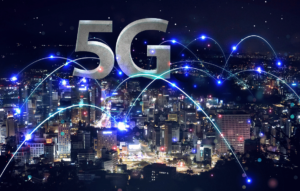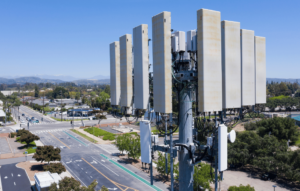In the era of rapid technological evolution, the rollout of 5G technology stands as a testament to humanity’s relentless pursuit of progress. Promising lightning-fast internet speeds and seamless connectivity, the advent of 5G networks announces a new age of innovation and digital transformation. Yet, amidst the excitement and anticipation, a growing wave of opposition has emerged, enough that almost 80 cell towers were attempted to be burned down over the course of a few months in the UK.
In this post we’re looking to unravel the complexities within this controversial issue, shedding light on the concerns driving resistance to the rollout of 5G infrastructure. Beyond the glossy facade of technological advancement lies some serious apprehension as communities grapple with the potential health, environmental, and electromagnetic field (EMF) risks posed by the pervasive installation of 5G towers in every corner of our cities and towns.
shedding light on the concerns driving resistance to the rollout of 5G infrastructure. Beyond the glossy facade of technological advancement lies some serious apprehension as communities grapple with the potential health, environmental, and electromagnetic field (EMF) risks posed by the pervasive installation of 5G towers in every corner of our cities and towns.
As we take on this exploration, it becomes clear that the debate surrounding 5G technology extends far beyond just the technical information – this conversation touches on much bigger questions of public health, environmental sustainability, and the societal impacts of unchecked technological expansion. Through an examination of these issues, we hope to bring you a deeper understanding of the reasons behind the resistance to 5G towers and empower individuals to engage in informed dialogue and advocacy.
We hope to inspire the world to work towards a future where technological progress is harmoniously balanced with the well-being of both people and the planet.
The Promise and Peril of 5G Technology
5G technology is presented, or rather marketed, as a beacon of evolution, offering unprecedented speed, connectivity, and the potential for big advancements across various sectors. With the ability to revolutionize industries, enhance communication networks, and fuel the growth of the digital economy, the allure of 5G is undeniable.
But, alongside its undeniable potential, 5G technology also brings forward a host of concerns and uncertainties. As we gawk at the prospect of lightning-fast downloads and seamless connectivity, questions remain about the potential trade-offs and risks associated with this huge leap in speed and power. These concerns encompass not only the immediate impacts on human health but also broader environmental and societal implications.

Health Risks and EMF Concerns
As most of the world eagerly, or passively, embraces the dawn of the 5G era, concerns regarding potential health risks and electromagnetic field (EMF) exposure have been brought into public discourse, though it has largely been dismissed as a “conspiracy theory” by traditional media. At the heart of these concerns lies the uncertainty surrounding the long-term effects of prolonged exposure to the radiation emitted by 5G towers.
Scientific research on the health impacts of EMF radiation has yielded conflicting findings, with some studies suggesting potential risks such as increased cancer risk, neurological disorders, and reproductive issues, while others assert that the levels of radiation emitted by 5G technology are within safe limits prescribed by regulatory bodies (though almost all admit that quality research is lacking in this area).
Despite ongoing debates within the scientific community, public concern around the potential health risks of 5G technology continues, fueled in part by the dissemination of misinformation and the lack of comprehensive research on the subject. As individuals grapple with the uncertainty surrounding EMF exposure, questions arise about the adequacy of existing regulatory frameworks in safeguarding public health and mitigating potential risks.
A significant concern for people is that the 5G antennas are almost everywhere; they can be seen mounted on top of most tall buildings, almost all water towers, and even churches and schools can be seen with 5G panels attached to them, not to mention the growing proliferation of poorly camouflage fake “tree” cell towers. What are the effects of living just 20 feet from one of the panels in one’s apartment? Is there an effect on the water that’s now surrounded by 5g panels? What about children in schools all day every day? There are definitely some big questions that need answered and the science we currently have is certainly insufficient to answer them.
A Practical Solution for EMF Protection: Aires Tech
While ongoing research continues to investigate the potential health effects of EMF exposure, it makes sense to take proactive steps to minimize the risks. Aires Tech

offers a scientifically-backed solution to help mitigate EMF-related concerns. Their advanced technology doesn’t just block EMFs – it alters electromagnetic radiation into a more biologically compatible form, reducing the potential for negative impacts on your health.
Whether you’re living near a 5G tower, working in a high-tech environment, or simply looking to protect yourself and your family, Aires Tech products provide a reliable, proven way to reduce EMF exposure without disrupting your daily routine.
Environmental Implications of 5G Towers
In the fervor surrounding the rollout of 5G tech’s effect on humanity, we also need to be careful not to overlook the environmental implications of all these 5G towers and panels. While 5G promises to bring faster connection and industrial developments, the rapid deployment of infrastructure necessary to support this technology comes with its own set of environmental challenges and concerns.
One of these concerns is the significant increase in energy consumption associated with 5G infrastructure, including the operation of towers, data centers, and other network components. This heightened energy demand not only contributes to carbon emissions and exacerbates climate change but also raises questions about the sustainability of 5G technology in the long run.
Furthermore, the deployment of 5G towers can result in the generation of electronic waste, as older infrastructure is replaced and upgraded to accommodate the new technology. The disposal of obsolete equipment poses challenges in terms of recycling and proper waste management, potentially leading to environmental pollution and ecosystem degradation.
Beyond these energy and waste impacts, the rollout of 5G towers also raises concerns about the disruption of ecosystems and wildlife habitats. As towers are built in urban and rural landscapes alike, the landscapes are transformed, leading to habitat fragmentation and loss of biodiversity for local species.
Regulatory and Public Policy Oversights
Another major concern is around the adequacy, and probable inadequacy, of regulatory agencies and preexisting public policies in addressing potential risks and safeguarding public health, environmental integrity, and societal well-being in this new era.
Existing regulatory frameworks governing electromagnetic field (EMF) exposure and telecommunications infrastructure vary across regions and countries, with some jurisdictions imposing strict limits on radiation levels, while others adopt more lenient approaches. This patchwork of regulations leaves room for ambiguity and inconsistency, complicating efforts to hold uniform standards and protections for communities across the globe.
What’s more, the rapid pace of technological advancement often, by its nature, outpaces regulatory development, leaving policymakers lagging behind emerging challenges and uncertainties. In the face of growing public concern, governments and international organizations should be able to be called upon to reassess existing regulations, conduct comprehensive risk assessments, and establish clear guidelines for the deployment and operation of 5G infrastructure, and not just simply dismiss the concerns of their constituents as they largely have thus far.

At the same time, public engagement and transparency are crucial in shaping effective regulatory frameworks and public policies that balance technological innovation with public health, environmental sustainability, and social equity. By cultivating dialogue among stakeholders, including government agencies, industry players, health experts, environmental advocates, and community representatives, policymakers could do a lot to gain valuable insights into the diverse perspectives and concerns surrounding 5G technology. There is certainly still hope, but the ball is in their court.
Closing Thoughts
In the wake of the debate surrounding the rollout of 5G towers, it’s clear that the adoption of this transformational technology is not without its challenges and uncertainties. From concerns about potential health risks and electromagnetic field (EMF) exposure to broader environmental and societal implications, the 5G debate touches upon fundamental questions of public health, environmental sustainability, and technological governance.
As we navigate the complexities of this discourse, it becomes clear that there is no simple solution or one-size-fits-all approach. Instead, addressing the multifaceted concerns surrounding 5G technology requires a nuanced understanding of the risks and benefits, as well as a commitment to informed decision-making, stakeholder engagement, and evidence-based policy formulation.
Moving forward, we must prioritize transparency, accountability, and public participation in shaping the future of 5G deployment. By fostering open dialogue among policymakers, industry stakeholders, health experts, environmental advocates, and community members, we can work toward solutions that balance technological innovation with the protection of human health, environmental integrity, and societal well-being.
Ultimately, the journey towards realizing the full potential of 5G technology has to be guided by a shared commitment to responsible innovation and sustainable development. By harnessing the power of collaboration, innovation, and collective action, we can pave the way for a future where 5G technology enriches our lives while safeguarding the health of our communities and the planet we call home.








